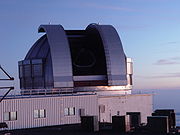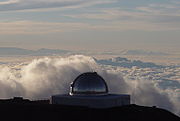
List of largest infrared telescopes
Encyclopedia
List of largest infrared telescopes, by diameter of entrance aperture, oriented towards large observatories dedicated to infrared astronomy
.
* For comparison
Infrared astronomy
Infrared astronomy is the branch of astronomy and astrophysics that studies astronomical objects visible in infrared radiation. The wavelength of infrared light ranges from 0.75 to 300 micrometers...
.
Overall
| Name | Image | Effective aperture Aperture In optics, an aperture is a hole or an opening through which light travels. More specifically, the aperture of an optical system is the opening that determines the cone angle of a bundle of rays that come to a focus in the image plane. The aperture determines how collimated the admitted rays are,... m (in Inch An inch is the name of a unit of length in a number of different systems, including Imperial units, and United States customary units. There are 36 inches in a yard and 12 inches in a foot... ) |
Wavelength Coverage | Site | Year | Refs |
|---|---|---|---|---|---|---|
| VISTA VISTA (telescope) The VISTA is a reflecting telescope with a 4.1 metre mirror, located at the Paranal Observatory in Chile. It is operated by the European Southern Observatory and saw first light in December 2009... |
4.1 m (161″) | Paranal Obs. Paranal Observatory Paranal Observatory is an astronomical observatory located on Cerro Paranal at 2,635 m altitude and operated by the European Southern Observatory. The Very Large Telescope is the largest telescope on Paranal, actually composed of four separate 8.2 m telescopes... , Chile |
2008 | |||
| UKIRT United Kingdom Infrared Telescope UKIRT, the United Kingdom Infra-Red Telescope, is a 3.8 metre infrared reflecting telescope, the largest dedicated infrared telescope in the world. It is operated by the Joint Astronomy Centre in Hilo and located on Mauna Kea, Hawai'i as part of Mauna Kea Observatory... |
 |
3.8 m (150″) | Mauna Kea Obs., Hawaii | 1978 | ||
| Herschel Obs. Herschel Space Observatory The Herschel Space Observatory is a European Space Agency space observatory sensitive to the far infrared and submillimetre wavebands. It is the largest space telescope ever launched, carrying a single mirror of in diameter.... |
3.5 m (138″) | 60-672 μm | Space, Earth L2 | 2009 | ||
| IRTF Infrared Telescope Facility The NASA Infrared Telescope Facility is a telescope optimized for use in infrared astronomy and located at the Mauna Kea Observatory in Hawai'i. It was first built to support the Voyager missions and is now the USA national facility for infrared astronomy, providing continued support to... |
 |
3 m (118″) | Mauna Kea, Hawaii Hawaii Hawaii is the newest of the 50 U.S. states , and is the only U.S. state made up entirely of islands. It is the northernmost island group in Polynesia, occupying most of an archipelago in the central Pacific Ocean, southwest of the continental United States, southeast of Japan, and northeast of... |
1979 | ||
| SOFIA Stratospheric Observatory for Infrared Astronomy The Stratospheric Observatory for Infrared Astronomy is a joint project of NASA and the German Aerospace Center to construct and maintain an airborne observatory. NASA awarded the contract for the development of the aircraft, operation of the observatory and management of the American part of the... |
2.5 m (98.4 in) | 747SP Boeing 747 The Boeing 747 is a wide-body commercial airliner and cargo transport, often referred to by its original nickname, Jumbo Jet, or Queen of the Skies. It is among the world's most recognizable aircraft, and was the first wide-body ever produced... ; Stratosphere |
2010 | |||
| WIRO | 2.3 m (90.6 in) | Jelm mountain, 9656 ft. (2943m) | 1977 | |||
Space telescopes only
| Name | Effective aperture Aperture In optics, an aperture is a hole or an opening through which light travels. More specifically, the aperture of an optical system is the opening that determines the cone angle of a bundle of rays that come to a focus in the image plane. The aperture determines how collimated the admitted rays are,... cm (in Inch An inch is the name of a unit of length in a number of different systems, including Imperial units, and United States customary units. There are 36 inches in a yard and 12 inches in a foot... ) |
Wavelength Coverage | Year | Refs |
|---|---|---|---|---|
| Herschel Obs. Herschel Space Observatory The Herschel Space Observatory is a European Space Agency space observatory sensitive to the far infrared and submillimetre wavebands. It is the largest space telescope ever launched, carrying a single mirror of in diameter.... |
350 cm (138″) | 60-672 μm | 2009 | |
| Hubble WFC3 Wide Field Camera 3 The Wide Field Camera 3 is the Hubble Space Telescope's last and most technologically advanced instrument to take images in the visible spectrum... |
240 cm | 0.2-1.7 μm | 2009 | |
| Spitzer Spitzer Space Telescope The Spitzer Space Telescope , formerly the Space Infrared Telescope Facility is an infrared space observatory launched in 2003... |
85 cm | 3-180 μm | 2003 | |
| Akari | 68.5 cm | 2-200 μm | 2006 | |
| ISO Infrared Space Observatory The Infrared Space Observatory was a space telescope for infrared light designed and operated by the European Space Agency , in cooperation with ISAS and NASA... |
60 cm | 2.5-240 μm | 1996 | |
| IRAS IRAS The Infrared Astronomical Satellite was the first-ever space-based observatory to perform a survey of the entire sky at infrared wavelengths.... |
57 cm | 5-100 μm | 1983 | |
| SWAS Submillimeter Wave Astronomy Satellite The Submillimeter Wave Astronomy Satellite was an astronomical observatory launched on December 5, 1998 as part of the Small Explorer program within NASA... |
44-70 cm | 540 - 610 μm | 1998 | |
| WISE Wide-field Infrared Survey Explorer Wide-field Infrared Survey Explorer is a NASA infrared-wavelength astronomical space telescope launched on December 14, 2009, and decommissioned/hibernated on February 17, 2011 when its transmitter was turned off... |
40 cm | 3-25 μm | 2010 | |
| Human Eye* | 1 cm | 0.39-0.75 μm | - | |

